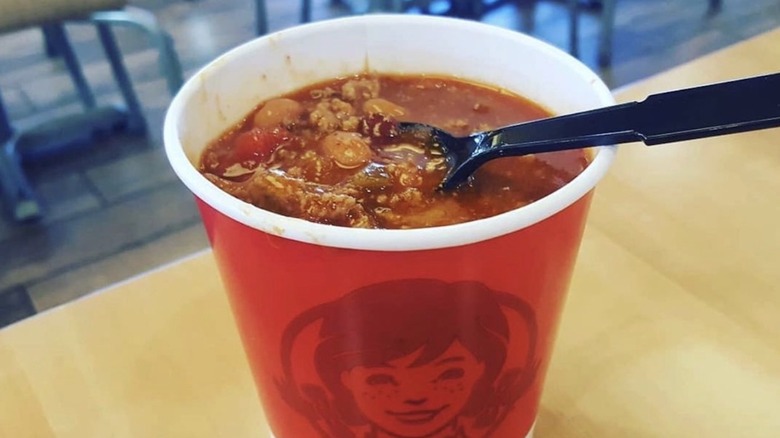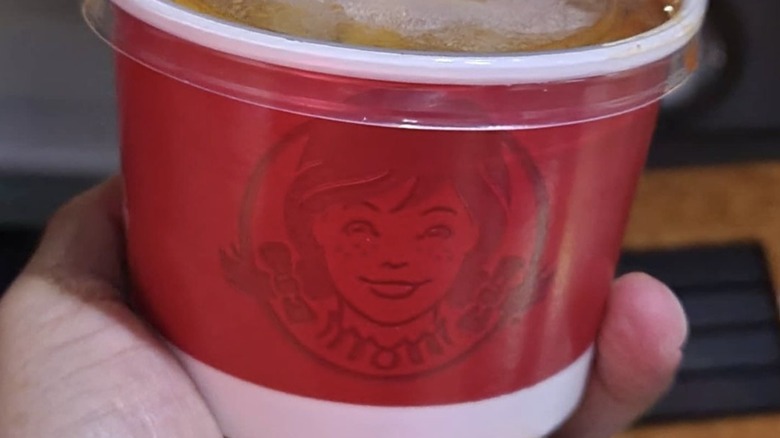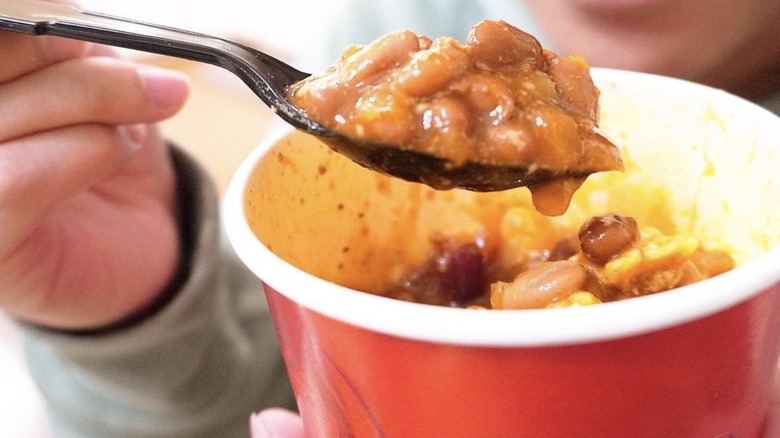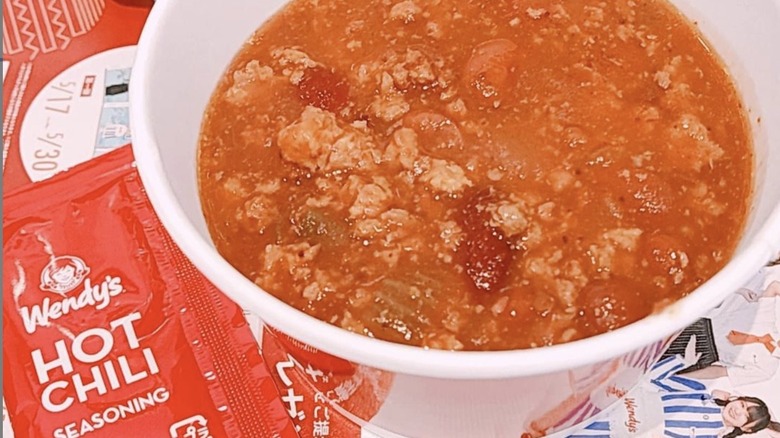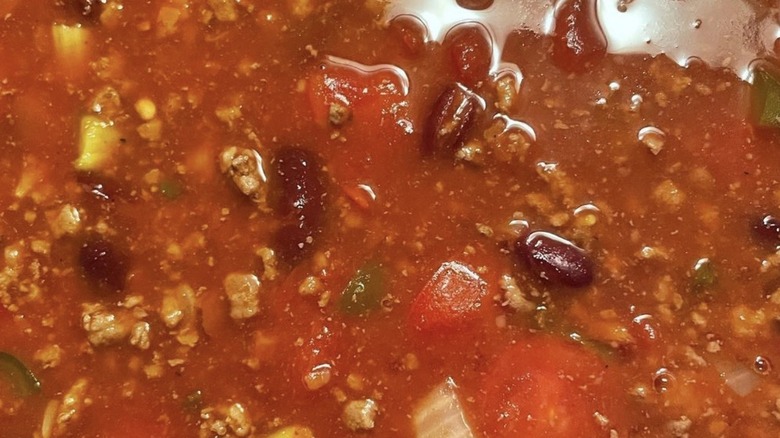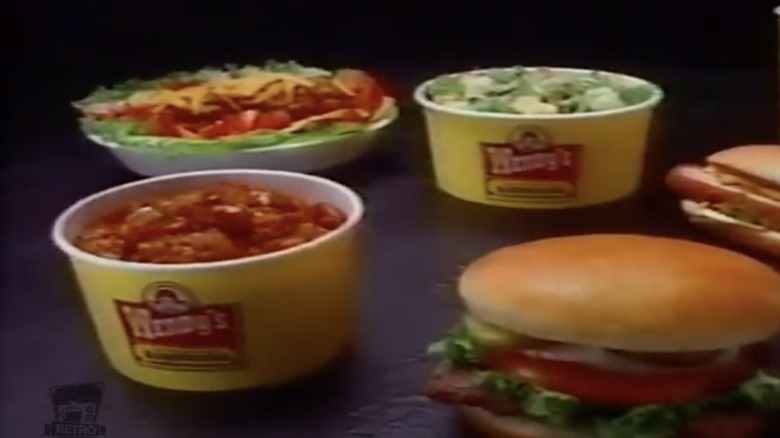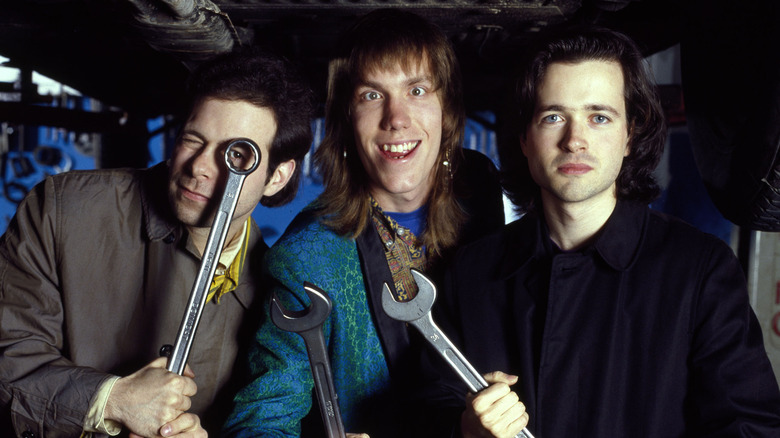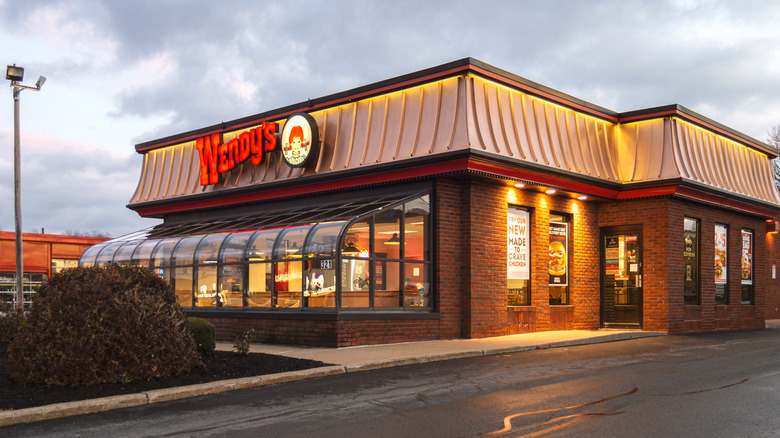The Untold Truth Of Wendy's Chili
There are literally thousands of spots in the United States to grab a quick burger and fries. Wendy's is among them, with more than 6,500 outlets in the U.S. alone. But what does the place famous for its illustrated redheaded mascot, never-frozen burgers, and an endless string of humorous commercials featuring the late Dave Thomas, also offer that no other major competitor even so much as attempts: Chili. Go into virtually any Wendy's anywhere, and they'll have a hot cauldron of the homestyle favorite just waiting for a ladle to dip in to serve up a cup or bowl of beef, tomatoes, beans, and various other assorted vegetables and spices to a customer in need of a filled belly or warm-up.
Chili (with or without cheese, onions, crackers, and hot sauce) is a definitive Wendy's menu item, if not a distinctive and unique part of the fast food scene. That chili has also got a history as rich as the chili itself that's been simmering for a little bit longer than the few hours it takes to get the recipe just right. Here's all there is to know about Wendy's famous chili.
The chili has always been a part of Wendy's
The full name of Wendy's is Wendy's Old Fashioned Hamburgers. That titular item has propelled the company for more than 50 years and propelled and informed its menu, even in non-traditional fast food side items. According to the chain's website, the first restaurant opened for business on November 15, 1969, with just one outlet in Columbus, Ohio. The initial menu was brief and extremely uncomplicated: Wendy's sold burgers (single, double, and triple patties), fries, soft drinks, the Frosty, and, in a wild card play that immediately differentiated itself from other fast food outlets — chili. It cost just 55 cents, the same as a single-patty hamburger did at the time (which works out to about $4 in 2021 money).
Even on the first day of operations, chili was a priority for Thomas, and Wendy's. According to the book "Dave's Way," the restaurant employed only three workers at opening, among them Thomas himself and Gloria Ward Soffe, who served as company bookkeeper, cash register operator, and chili maker. That means making sure the chili tasted good was just as important to Thomas as the handling of the fledgling business's finances.
Wendy's chili cuts down on food waste
Wendy's grew into one of the biggest and most dominant hamburger chains on the planet, serving both classical and experimental takes on the beef/cheese/bun formula, along with plenty of other standard fast food items like fries, chicken sandwiches, chicken nuggets, and kids' meals. Even after more than 50 years on the scene, not too many other mainstream, hamburger-oriented fast food outlets have ever bothered to take Wendy's lead and sell an original-recipe chili. It's such an anomaly that in his book "Dave's Way," Wendy's founder Dave Thomas admitted that "people have often asked me why we had chili on the menu from the start." His justification is viable both in 1969 and today: It was a way to cut down on food waste and turn a small profit off of meat that would ordinarily have gone to waste. "It's real easy: What do you do with the leftover hamburger?" Thomas wrote.
Fast food workers have to work, well, fast, and sometimes that means grilling up enough burgers to meet anticipated demand. But what happens to patties that get cooked (or overcooked) but not sold or eaten? Some restaurants would just throw them away and suffer financial loss. Wendy's doesn't do that — it saves unsellable meat for its famous chili. "It's then cut up, frozen, and bagged for later use in the chili," a Wendy's shift manager said on Reddit.
Wendy's chili is literally homemade
Even though Dave Thomas wanted — and astutely calculated the need for — hot chili on the Wendy's menu before he even opened his first store in 1969, he was initially but briefly stymied on just how exactly he was going to pull it off. "The recipe was the hard part," Thomas wrote in his memoir "Dave's Way." The exact combination of beef, spices, vegetables, and multiple kinds of beans was struck upon only after what Thomas called "marathon cooking sessions" that took place in his own kitchen at home (led by his wife, Lorraine) and in the kitchen of Charlotte Immke, spouse of Len Immke, a car dealer and close friend of Thomas who also helped secure the real estate to open the first Wendy's.
Lorraine Thomas and Charlotte Immke developed and finalized the recipe for Wendy's chili that was sold in the first restaurant on the first day, and hasn't really changed all that much since. The most striking change to Wendy's chili over the years has been a largely external factor: the cost of making it. In 1979, according to Thomas, wholesale ground beef prices doubled to $1.40 a pound. "We had to raise our menu prices and that hurt our business," he wrote. By the turn of the new decade, Wendy's overall sales chain-wide had dropped by 17 percent.
Is Wendy's chili really chili?
Wendy's says it's chili is chili, and upon a quick examination, it certainly seems like chili — it smells like onions and tomatoes and is made with beef and piquant spices and flavorings, after all. But some chili purists could argue that Wendy's chili is not, technically that. It's full of vegetable chunks (particularly tomatoes) as well as beans. In Texas-style chili, vegetables are cooked and broken down or pureed until they're part of the whole, reddish-brown mixture, while beans are generally not included at all. And all those ingredients float inside of a fairly thin broth, unlike the rich, thick, gravy-meets-marinara texture of Texas chili. Wendy's chili, in other words, is a beef-and-bean soup.
But whatever it is, Wendy's uses a not-so-secret recipe for its signature spoon-and-bowl hot-and-soft spicy mush. According to Secret Sauce, in 1994 Wendy's founder Dave Thomas contributed his recipe for "Old Fashioned Chili" to "Colorado Cooks For Education," a charity cookbook sold to raise funds for Colorado schools. From the brain of Thomas himself, the key ingredients in Wendy's chili are ground beef, tomato juice, tomato puree, red kidney beans, small red beans, onion, celery, chili powder, cumin, garlic powder, salt, pepper, oregano, cayenne, and sugar.
Wendy's chili was a vital part of the first fast food dollar menu
Countless diners swear by fast food value menus, feeding themselves and their families for just a couple of bucks a pop, building a meal from a wide array of cheaply-priced small-to-medium entrees, sides, beverages, and treats. According to QSRweb, Burger King debuted a value menu in 1998, and McDonald's launched its first Dollar Menu in 2003, both more than a decade after Wendy's originated the concept. During a fast food price war, in which Burger King and McDonald's deeply cut the price of the Whopper and Big Mac, respectively, to 99 cents, Wendy's took a different approach. "We had the idea of rather than selling one of our big items at 99 cents, creating a whole menu with 99-cent items," Wendy's senior VP of communications said.
And so, in 1989, Wendy's launched the Super Value Menu. The new menu promised the attractive idea of several popular Wendy's items that each cost a dollar minus a penny. Among the first, most attention-getting sides: Wendy's flagship Frosty and chili.
Wendy's chili carved a deep rift in a popular rock band
A 2007 commercial for Wendy's chili featured the Violent Femmes' "Blister in the Sun." Probably the best-known song of the Milwaukee indie rock trio, it appeared on the group's self-titled 1983 debut album and has popped up in many movies and TV shows. Composed by Femmes frontman Gordon Gano, "Blister in the Sun" is an early college rock classic, and it's also a song about teenage sexual frustration, which are only two of the reasons why it's surprising that it ever appeared in a Wendy's chili ad. OnMilwaukee columnist Andy Tarnoff discussed his bafflement, and Femmes bassist Brian Ritchie wrote in to explain the situation."Gordon Gano is the publisher of the song and Warners is the record company. When they agree to use it there's nothing the rest of the band can do about it," Richie wrote. "Therefore when you see dubious or in this case disgusting uses of our music you can thank the greed, insensitivity, and poor taste of Gordon Gano, it is his karma that he lost his songwriting ability many years ago, probably due to his own lack of self-respect." The musician added that as a "gourmet," he avoids eating "garbage like Wendy's."
According to Billboard, Ritchie sued Gano, seeking proper recognition as co-writer of several Violent Femmes songs while also calling out his bandmate for sullying the group's good name by allowing its music to be used in ads.
Wendy's suffered from a gruesome hoax involving its chili
According to the Associated Press (via The Guardian), a diner at a Wendy's in San Jose, California, found what was undeniably a human finger in her bowl of chili in March 2005. Within weeks, according to The Smoking Gun, San Jose police believed that they had figured out the identity of the person who put the finger in the chili: Anna Ayala, the Wendy's customer who had found the severed digit in her chili (and who was threatening to sue). Ayala had a history of filing suits and then accepting a cash buyout before trial, and police discovered some inconsistencies in her story. Tracing of the chili ingredients "revealed no contamination or accidents" according to a police report, leading authorities to the conclusion that Ayala had snuck in the finger. Ayala later admitted (per the San Jose Mercury News, via the Seattle Times) to pre-cooking the finger, and placing it in the chili. It belonged to Jaime Plascencia, a coworker of Ayala's husband, who'd severed it in a work accident and sold it to the Ayalas for $100.
Even though it was cleared of wrongdoing, Wendy's suffered financial losses in the month after Ayala's initial discovery, bleeding about $1 million a day in lost revenue. Ayala, meanwhile, earned a prison sentence of four years, per CBS News.
